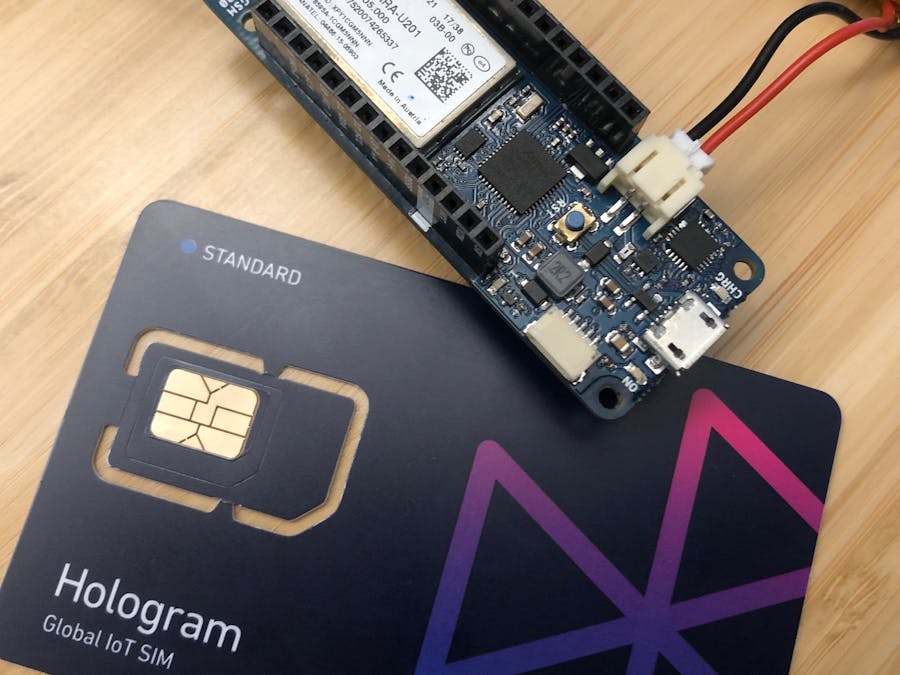We're going to explore various uses of the Arduino MKR 1400 GSM for cellular projects! From wardriving for cell towers to connecting to IoT platforms!
Objectives:- Activate Hologram.io SIM card
- Install Arduino IDE along with MKR 1400 board definition, MKRGSM and ArduinoMQTTClient libraries
- Set up the Arduino MKR 1400
- Test SMS and GPRS connections (to verify everyone is in a workable state)
- Cellular wardriving example
- Network hopping
- Use MQTT over cellular to connect to an IoT platform
Hologram.io is a cellular network provider perfect for makers. At $0.60 /mo plus $0.40 per mb, you'll have plenty of data for most IoT projects. You can get a free SIM card by going to hologram.io and then activate it at dashboard.hologram.io.
We'll provide Free Credit codes, so you wont have to put in any billing information for this workshop!
Its important to do this part first so that your SIM has time to activate as we set up our coding environment.
Install Arduino IDEDownload the Arduino IDE at the following link. We will not be using the online code editor for this project.
https://www.arduino.cc/en/Main/Software
Install MKR 1400 Board Definition- Open Arduino IDE
- Go to Tools > Board > Boards Manager
- Search MKR and an entry for "Arduino SAMD Boards" will show up, install that
- Open the Arduino IDE
- Go to Sketch > Include Library > Manage Libraries
- Search for MKRGSM and install it
- Search for ArduinoMqttClient and install it
- Insert the SIM card into the Arduino MKR 1400 as shown above
- Attach the antenna
- Plug in the battery (Needs to be at least 1500 maH)
- Connect the USB cable
- Open the Arduino IDE, select "Arduino MKR 1400" in Tools > Board
- In Tools > Port select your board (it should be obvious which one to select)
https://github.com/benstr/GSM-Network-Jumper-Example
This example demonstrates quickly jumping to different carriers on the fly. It scans and prints available carriers to the serial monitor and waits for user input.
The custom function "jumpCarrier" sends AT commands directly to the modem.
Available Commands:
"att" - AT&T 3G
"tmo2" - T-Mobile 2G
"tmo3" - T-Mobile 3G
Copy the code from the above link into a new sketch, upload, and open the Serial Monitor and give it a try!
A combination of this method and the Wardriving example could be used for some interesting network exploration shenanigans...
Test SMS- In Arduino, open Examples > MKRGSM > Receive SMS
- Click upload!
- Click the magnifying lens icon to open the Serial Monitor
- Go back to dashboard.hologram.io and select your device
- Click the "via SMS" tab under "Send a Message"
- Type some arbitrary message and hit send!
You should see output in the Serial Monitor similar to this!
SMS Messages Receiver
GSM initialized
Waiting for messages
Message received from:
+44793740520
Hello World!
END OF MESSAGE
MESSAGE DELETED
This code will simply attempt to connect to GSM and GPRS and confirm success or fail.
APN Information
When connecting to a GPRS network you typically need to include an Access Point Name and login credentials. In the case of the Hologram.io network you simply need to include "hologram" as the APN and leave login credentials blank!
- In Arduino, click File > New
- Paste in the code from below
- Upload!
- Open the Serial Monitor
#include <MKRGSM.h>
const char PINNUMBER[] = " ";
// APN data
const char GPRS_APN[] = "hologram";
const char GPRS_LOGIN[] = " ";
const char GPRS_PASSWORD[] = " ";
// initialize the library instance
GPRS gprs;
GSM gsmAccess;
void setup() {
// initialize serial communications and wait for port to open:
Serial.begin(9600);
while (!Serial) {
; // wait for serial port to connect. Needed for native USB port only
}
Serial.println("Starting Arduino web client.");
// connection state
boolean connected = false;
// After starting the modem with GSM.begin()
// attach to the GPRS network with the APN, login and password
while (!connected) {
Serial.println("Begin GSM Access");
//Serial.println(gsmAccess.begin()); //Uncomment for testing
if ((gsmAccess.begin() == GSM_READY) &&
(gprs.attachGPRS(GPRS_APN, GPRS_LOGIN, GPRS_PASSWORD) == GPRS_READY)) {
connected = true;
Serial.println("GSM Access and GPRS Success");
}
else {
Serial.println("Not connected");
delay(1000);
}
}
}
void loop() {
}
Output should look like this
Starting Arduino web client.
Begin GSM Access
GSM Access and GPRS Success
Ever been curious about the locations of cell towers and coverage?
There are plenty of awesome utilities and functions available in the MKRGSM Library (See Reference), we'll be using the Location and Scan Networks instances for this example. The expected output is triangulated GPS location along with any nearby carriers and their signal strength.
- Copy the code from https://github.com/HologramEducation/iot-dev-fest-2019/blob/master/basic-wardriver.ino to a new sketch
- Upload!
- Open the Serial Monitor (starting the get the idea yet?)
Example Output:
GSM networks scanner
Starting GSM location.
Modem IMEI: 357520074233053
> T-Mobile
> AT&T
Current carrier: 0041005400260054
Signal Strength: 13 [0-31]
Location: 38.0000000, -97.0000000
Altitude: 0m
Accuracy: +/- 4100000m
MQTT (Message Queuing Telemetry Transport) is probably the most commonly used messaging protocol for the Internet of Things. We're going to connect the Arduino MKR 1400 to an MQTT broker to create a very basic IoT application!
Thankfully, the MKRGSM library gives us a client object that is interchangeable with WiFi or Ethernet clients. Meaning we can just drop it into existing network libraries.
We'll be creating an MQTT connection to a public MQTT broker and using it to publish and subscribe to topics. The example sketch provided will print out incoming messages from the subscribed topic to the serial console. It will also periodically publish a sensor value to a separate topic.
We'll use chirpers.io to interact with the Arduino remotely! Chirpers is essentially a fork of node-red that runs entirely client-side in the browser and lets you interact with hardware and web services to build IoT applications visually!
Program the sketch!- Create a new sketch
- Copy https://github.com/HologramEducation/iot-dev-fest-2019/blob/master/MKRGSM_MQTT_PUB_SUB/MKRGSM_MQTT_PUB_SUB.ino into the main sketch
- Create a new tab and name it "arduino_secrets.h"
- Copy in https://github.com/HologramEducation/iot-dev-fest-2019/blob/master/MKRGSM_MQTT_PUB_SUB/arduino_secrets.h to the arduino_secrets file
The secrets file has all your credentials for GPRS, in this case we only need the APN which is already set to Hologram. We're going to add the MQTT server credentials next.
Broker: iot.eclipse.org
Port: 1883
topic: hologram-YOUR-NAME/to (this is for messages to your device)
publishTopic: hologram-YOUR-NAME/from (messages from your device)
Upload the code and open the Serial Monitor!
Chirpers!We don't need to create an account to use chirpers.com . Since it runs in your browser, it also saves everything in your local storage.
- Go to https://chirpers.com/browser/
- Drag in an inject node. This is basically a trigger to kick off a message. By default it outputs a timestamp.
- Drag in an MQTT out node. This lets us publish messages. Connect the inject node to it.
- Double click on the MQTT out node. Click the edit icon to add a new broker.
Broker Settings
Server: wss://iot.eclipse.org:443/ws
- Click update
- Add your hologram/to topic in the topic field.
- Do the same with an MQTT out node to a Debug node but use your hologram/from topic.
- Click Run!
Clicking the inject should send a timestamp to your Arduino MKR which will reflect on the Serial Monitor.
Sensor values from your Arduino MKR should show in the Debug tab on Chirpers!
Your main loop is where you can change what messages you are sending. Bonus points if you do something interesting ;)
void loop() {
// call poll() regularly to allow the library to receive MQTT messages and
// send MQTT keep alives which avoids being disconnected by the broker
mqttClient.poll();
// Set the rate at which we send our values
delay(1500);
// read the first Analog pin
int sensorVal = analogRead(0);
// Publish our sensor value
mqttClient.beginMessage(publishTopic);
mqttClient.print(sensorVal);
mqttClient.endMessage();
}
This function at the end of the sketch handles incoming messages
void onMqttMessage(int messageSize) {
// we received a message, print out the topic and contents
Serial.println("Received a message with topic '");
Serial.print(mqttClient.messageTopic());
Serial.print("', length ");
Serial.print(messageSize);
Serial.println(" bytes:");
// use the Stream interface to print the contents
while (mqttClient.available()) {
Serial.print((char)mqttClient.read());
}
Serial.println();
Serial.println();
}
Chirpers Flow
If you wanna cheat you can copy this and import it into your flow from the chirpers.io menu. Just be sure to change the topics to match yours!
[{"id":"5199e666.cafc58","type":"mqtt-broker","z":"91xN7kD2zjI","server":"wss://iot.eclipse.org:443/ws","clientId":"","username":"","password":""},{"id":"SDgXjXm8EXM","type":"mqtt in","z":"91xN7kD2zjI","name":"","topic":"hologram/from","broker":"5199e666.cafc58","x":96,"y":117,"wires":[["q-msFzzDVmw"]]},{"id":"q-msFzzDVmw","type":"debug","z":"91xN7kD2zjI","name":"","active":true,"console":"false","complete":"false","x":287,"y":116,"wires":[]},{"id":"mib-Z2IUCWQ","type":"inject","z":"91xN7kD2zjI","name":"","topic":"","payload":"","payloadType":"date","repeat":"","crontab":"","once":false,"allowDebugInput":false,"x":101,"y":39,"wires":[["TCHX2DIYKn4"]]},{"id":"TCHX2DIYKn4","type":"mqtt out","z":"91xN7kD2zjI","name":"","topic":"hologram/to","broker":"5199e666.cafc58","x":267,"y":39,"wires":[]}]
















Comments
Please log in or sign up to comment.